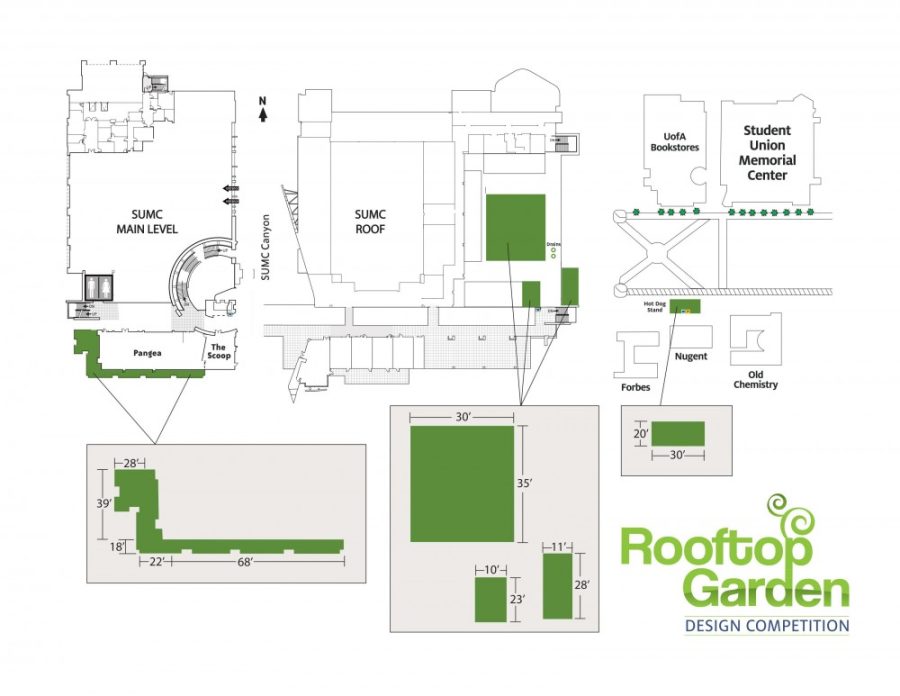Twenty-four teams made pitches for the Student Union Memorial Center’s Rooftop Garden Competition last week, each comprised of five undergraduate students. As organizers hoped, the teams were made up of students from a broad range of disciplines and backgrounds, each with a completely unique perspective on how exactly to develop a rooftop garden at the SUMC. This marks the second step in the Rooftop Garden Competition launched earlier this month.
On Thursday and Friday, the teams pitched five-minute presentations to judges and master gardeners of Tucson. Each team had a chance to get feedback and mingle with mentors before the first round of elimination.
The teams’ backgrounds influenced their presentations. One pitch, by a team of College of Agriculture and Life Sciences students, had already planned the crop cycles of the gardens. Another, made up of business, neuroscience, engineering and biology majors, gave a less focused but more comprehensive presentation to the judges, reflecting their mixed backgrounds.
RELATED: Urban agriculture: feeding the future
While many teams are hoping to implement high-tech agricultural practices, others see the garden as an aesthetic and cultural opportunity.
“We want it to match the terrain, and we want it to look good,” said John Devlin, a senior studying engineering. “We want to implement more art for the garden.”
Devlin went on to highlight the importance of murals and other art forms to the Tucson community. Their team hopes to design a garden that will be both productive and engaging.
While winners and runners-up could snag up to $1,000 in meal plan money, the competitors had diverse motivations.
“If 25 years from now I’m able to take my kid and show them I helped design this, that is really worth more than the prize money,” Devlin said.
Director of Arizona Student Unions Todd Millay explained between pitches that he almost wished he could dissolve the teams and let them all work together because the variety of perspectives was amazing. However, too many cooks in the kitchen spoils the broth.
“For the garden, it’s not just about how it looks, but it’s the functionality and strategy behind it that will allow it to better serve the community,” said Jacqueline Nguyen, a sophomore studying business.
She brings the financial perspective to team ARKA, which is otherwise comprised of architecture students.
Money does play an important role in the competition. Contestants can design their garden across five different areas in and around the SUMC. Three are on the upper levels and the other two are in front of the Nugent building and outside of the Pangea restaurant. The teams will have to work within a budget of $50,000, which will certainly be a limiting factor for teams with especially complex or costly designs.
Another concern that appeared to be unanimous among the contestants was the weight-bearing capacity of the roof. Teams will have to face the challenge of estimation in the early stages of the design process and avoid producing anything that weighs too much for the building’s structure to support.
RELATED: Rooftop garden competition highlights the future of food production
One team was made up entirely of Students for Sustainability members. A top issue for the group was responsible practices, and along with rainwater harvesting, they would like to implement a relationship with the UA Compost Cats organization to provide soil for the garden.
Regardless of their perspectives, the Rooftop Garden Competition provides a very rare opportunity for undergraduates to design a piece of their campus. This is the motivating factor for many of the contestants.
“Other people in our major don’t have a built design [in their portfolio],” said Jenny Nguyen, a junior studying architecture. “Having a built design is a really good thing to have. Leaving a mark after you graduate is a good thing.”
The main goal for this garden is to serve as a conduit for students to help students. The produce will go to the UA Campus Pantry and student union restaurants. But more than that, the garden will be an educational asset to the UA and a step forward in urban agriculture.
“I think this is a visionary project,” said Chester Phillips, sustainability coordinator for the Associated Students of the University of Arizona. “I think we should be very proud to have Todd Millay as director of our student union, and union staff who are willing to introduce a project like this, who are open to student ideas in a collaborative and constructive way.”
RELATED VIDEO: Urban agriculture: feeding the future
RELATED: Rooftop garden competition highlights the future of food production
Follow Chandler Donald on Twitter.









